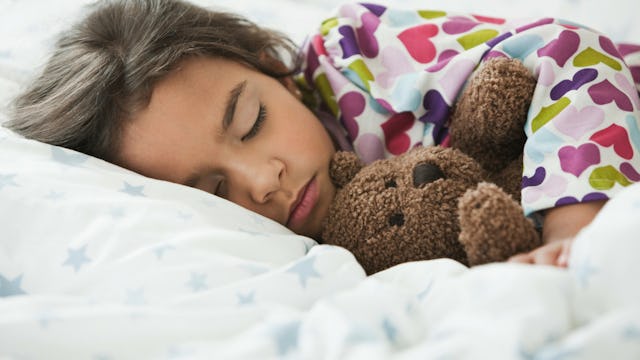No Sh*t Sherlock. Study Says Good Sleep Has The Greatest Impact On Kids’ Happiness

Most parents have experienced the head-swimming, butt-dragging reality of sleep deprivation at some point. I remember thinking with my first baby that it wasn’t humanly possible to survive on such little uninterrupted sleep. The first time I got a full night’s slumber post-kids, I felt like an entirely new woman.
So it really comes as no surprise that kids who don’t get regular, solid sleep probably aren’t as happy as those who do. In fact, a survey of 47,000 kids in Australia found that getting the right amount and quality of sleep was the greatest predictor of kids’ happiness — more than friends, family, music, or sports. Kids who reported sleeping well were twice as likely to report feeling happy most of the time as those who didn’t.
Happiness isn’t the only thing sleep-deprived kids sacrifice. “Children who don’t get enough sleep can also struggle with behavior, emotions, concentration and memory in the classroom,” said Dr. Jon Quach of Melbourne Graduate School of Education.
Kids’ bodies are growing and their brains are constantly developing, so they have an even greater need for sleep than adults. But a lot of children struggle to get adequate sleep. Some come from homes with family violence or trauma. Others are dealing with social problems like bullying or mental health issues such as depression or anxiety. Some kids are simply rough sleepers, but those who feel safe and secure are more likely to sleep well.
Technology may play a role in preventing some kids from getting adequate sleep. Screens emit a blue light that can interfere with the production of melatonin, a hormone that helps control the sleep and wake cycles. Since 47% of kids in the survey reported having a screen-based device within reach at least a few nights a week, nighttime screen use may be contributing to kids’ sleep problems. (And adults too. Hello, bedtime Netflix binge.)
While televisions in the bedroom used to be the main screen concern, now it’s tablets, laptops, and smartphones. But used in the right way, technology could actually help some kids prepare for a good night’s rest. “Technology is evolving, and in addition to disrupting sleep, mobile devices may also be used for child relaxation activities including reading, music and mindfulness applications,” says Dr. Bjorn Nansen of the University of Melbourne.
That has been the case in our house. My kids usually listen to relaxing stories on the iPad before they fall asleep. We just make sure it’s kept on the dresser by the door and not in their beds.
If you’re concerned with how your children are sleeping, here are some ways to encourage healthy sleep habits:
– Get them moving during the day. Exercise helps tire out the body in addition to balancing the hormones that help the brain’s sleep cycles.
– Shut off screens at least two hours before bedtime. Evening exposure to blue light tricks the brain into thinking it’s daytime. Some devices have settings that dim blue light after a certain time, but considering how excited my kids can get on the iPad, replacing screen time with reading or other calming activities before bed seems like a good idea anyway.
– Make sure their room is dark, quiet, and cool. Those three environmental factors can make or break a quality night’s sleep.
– Have a simple, solid bedtime routine. Pajamas, brush teeth, go potty, read a story, say a prayer or share some thoughts, and lights out. Easier said than done (my kids are certified experts at disrupting the bedtime routine), but predictability is good.
– Keep a regular bedtime. Consistency with bedtimes helps kids’ bodies develop a rhythm for their sleep-wake cycles. Try to get kids into bed at approximately the same time every night, even on weekends.
Lots of parents struggle with their kids’ sleep routines and some kids are naturally night owls, so don’t fret if your kid isn’t snoring by 8:00 every night. Parents everywhere want their kids to sleep well, for their health and our sanity, but we also know it is much easier said than done.